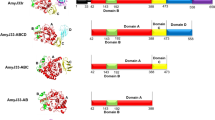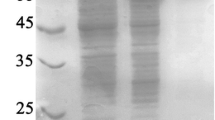Abstract
Characteristics of two rice α-amylases Amy1A and Amy3D, and those of two chimeric enzymes Amy1A/3D and Amy3D/1A, engineered from the two isozymes, were compared in the light of the functional roles of protein domains in α-amylase. The enzymes that have an Amy1A-type N-terminal domain, Amy1A and Amy1A/3D, showed high activity against soluble starch, while the enzymes that have an Amy3D-type barrel structure, Amy3D and Amy1A/3D, showed high activity in oligosaccharide hydrolysis. Rigidity of protein folding also significantly affected the enzyme activity in both soluble starch and oligosaccharide hydrolysis. Thus, the present work suggests that the structure of the N-terminal domain is important for stability and soluble starch hydrolysis, while the barrel structure that forms the active site significantly affects enzyme activities in oligosaccharide degradation.
Similar content being viewed by others
Author information
Authors and Affiliations
Additional information
Received: 27 September 1996 / Received revision: 21 October 1996 / Accepted: 15 November 1996
Rights and permissions
About this article
Cite this article
Terashima, M., Hosono, M. & Katoh, S. Functional roles of protein domains on rice α-amylase activity. Appl Microbiol Biotechnol 47, 364–367 (1997). https://doi.org/10.1007/s002530050941
Issue Date:
DOI: https://doi.org/10.1007/s002530050941




